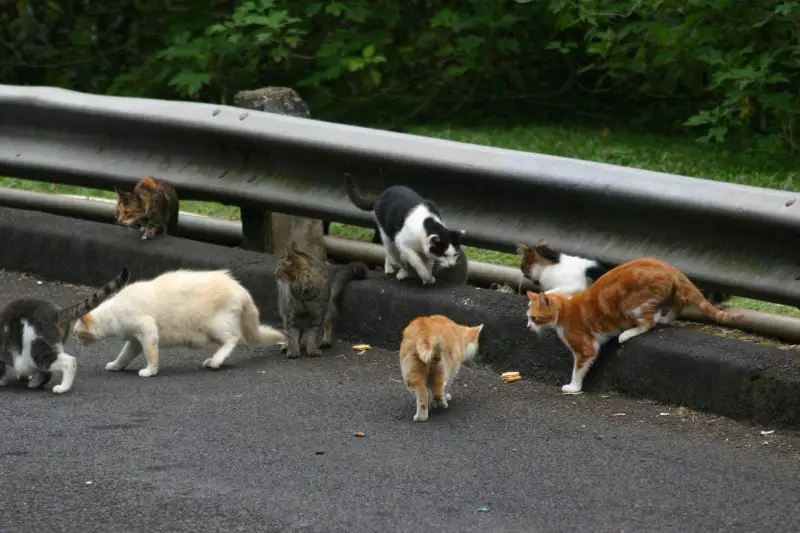Hawaii’s lush islands are famous for their incredible biodiversity — but also for the constant tension between native wildlife and invasive species. Among these invaders, few are as controversial as the feral cat. These free-roaming cats, descended from domestic pets, have become one of the most widespread and impactful predators in the Hawaiian Islands.
Every year, thousands of native birds and small animals fall prey to feral cats. Conservationists call them a major ecological threat, while animal-welfare advocates defend them as creatures deserving care and compassion. Amid this moral debate lies a legal question that many residents and property owners ask: Is it legal to kill feral cats in Hawaii?
The answer is not simple. While Hawaii does recognize feral cats as an invasive species, killing them without proper authorization may violate state cruelty laws. This article will break down the law, explain what actions are legal or illegal, and offer humane and lawful alternatives for managing feral cat populations in the islands.
Understanding the Feral Cat Problem in Hawaii

What Are Feral Cats?
Feral cats are the same species as domestic cats (Felis catus), but they live without human care or control. Unlike stray cats — which are typically lost or abandoned pets — feral cats are born and raised in the wild. They often form colonies near food sources such as garbage dumps, parks, and coastal areas.
These cats rarely interact positively with people and are not easily adoptable. They survive by hunting birds, reptiles, insects, and small mammals, or by scavenging human leftovers.
Ecological Impact of Feral Cats
Feral cats pose one of the most significant threats to Hawaii’s fragile ecosystems. Because the Hawaiian Islands evolved without native land mammals (other than bats), many bird species are defenseless against predation. Cats have contributed to the decline or extinction of several native species, including seabirds that nest on the ground.
Additionally, feral cats are carriers of Toxoplasma gondii, the parasite that causes toxoplasmosis. This disease is fatal to some wildlife species such as the endangered Hawaiian Monk Seal and native birds. According to Hawaii’s Department of Land and Natural Resources (DLNR), cat feces washing into waterways have become a major environmental and public-health issue.
Why People Want to Kill Feral Cats
Given the damage feral cats cause, some individuals, farmers, and conservationists have considered lethal control as a management method. However, despite the ecological justification, killing feral cats is not automatically legal. Hawaii’s animal-cruelty statutes and local ordinances create strict limitations on when and how animals can be euthanized or controlled.
The Legal Framework: What Hawaii Law Says
Hawaii’s Animal Cruelty Laws
Hawaii’s primary animal protection laws are found under Hawaii Revised Statutes (HRS) Chapter 711, specifically Sections 711-1108.5 and 711-1109.
- Cruelty to Animals in the First Degree (§711-1108.5)
This law prohibits intentionally or knowingly torturing, mutilating, poisoning, or causing serious bodily injury or death to any pet animal without legal authority or the owner’s consent. Violations can be prosecuted as a felony. - Cruelty to Animals in the Second Degree (§711-1109)
This section makes it a crime to intentionally, knowingly, or recklessly overwork, torture, or kill an animal without need. The only exceptions apply to “insects, vermin, or other pests.”
At first glance, these laws seem straightforward — but they become complicated when we consider feral cats, which are not typically owned by anyone yet are still legally classified as animals, not vermin.
Feral Cats Are Not Classified as Vermin
Hawaii does not classify feral cats as pests in the same category as rats or invasive insects. They are considered non-native mammals but still fall under the definition of “animal” for cruelty statutes. This means they cannot be killed arbitrarily.
Anyone who kills a feral cat intentionally, without proper legal authority, risks being charged with animal cruelty. The penalties can include:
- Fines up to $10,000
- Up to five years in prison for first-degree offenses
- Community service or probation for lesser charges
The Exception: Authorized Lethal Control
While individuals cannot take matters into their own hands, authorized agencies or professionals may conduct lethal control as part of sanctioned wildlife-management programs. These include:
- The Hawaii Department of Land and Natural Resources (DLNR), which oversees invasive-species control.
- The U.S. Fish and Wildlife Service, which manages federal refuges where feral cats threaten endangered species.
- Licensed animal-control or pest-management agencies acting under specific permits.
Such operations follow ethical protocols — including humane euthanasia methods — and must comply with environmental regulations.
Can Property Owners Kill Feral Cats on Their Land?
When It’s Illegal
For most private citizens, it is illegal to kill feral cats on private or public property without official permission. Doing so may lead to prosecution for cruelty or illegal discharge of weapons, depending on the method used.
For example, shooting, poisoning, or trapping cats without authorization are all prohibited. In several cases, Hawaii courts have ruled that killing cats, even if feral, can violate animal-cruelty laws.
When It Might Be Permitted
There are only narrow circumstances where lethal control might be permitted:
- When performed by or under contract with a government agency conducting wildlife management.
- When done by a licensed veterinarian or humane society as part of an approved euthanasia program.
- When the animal poses an immediate and serious threat to human safety (for example, attacking livestock or humans).
Even in those cases, strict documentation and justification are required. Killing a cat because it is a nuisance, defecates in gardens, or kills birds on private property does not qualify as legal justification.
Hawaii’s Approach to Feral Cat Management
Trap-Neuter-Return (TNR) Programs
Rather than killing cats, Hawaii increasingly supports Trap-Neuter-Return (TNR) as a humane control method. In TNR programs:
- Feral cats are trapped using live traps.
- They are spayed or neutered by veterinarians.
- They receive vaccines (including for rabies).
- They are returned to their original location.
TNR reduces breeding, stabilizes colony size, and gradually decreases feral cat populations over time. Several counties, including Honolulu and Maui, work with nonprofits and local volunteers to manage colonies through TNR.
DLNR’s Conservation Programs
The DLNR’s Division of Forestry and Wildlife has ongoing programs to protect endangered seabirds and other native species from predation. On sensitive conservation lands, feral cats may be trapped and humanely euthanized — but only under government supervision and within strict environmental-impact rules.
Feeding Bans and Local Ordinances
Some counties, like Maui and Kauai, have debated or enacted feeding bans that prohibit feeding feral cats in public parks and coastal areas. These regulations aim to reduce colony growth by limiting food sources. Violating such rules may result in fines.
Ethical and Practical Considerations
The Moral Debate
The issue divides communities:
- Conservationists argue that feral cats devastate native wildlife and should be removed from sensitive habitats.
- Animal advocates emphasize that cats are sentient beings deserving compassion and that killing them is cruel and counterproductive.
Both perspectives have merit. While ecological protection is vital, animal welfare cannot be ignored. The most sustainable approach seeks balance through humane management rather than uncontrolled killing.
The Public-Health Dimension
Beyond ethics and wildlife, feral cats affect human health. They can transmit diseases like toxoplasmosis and cat-scratch fever. Pregnant women, immunocompromised individuals, and those living near feral colonies are particularly at risk. Thus, controlling cat populations benefits both wildlife and communities — but must still comply with the law.
What to Do If You Have Feral Cats on Your Property
If feral cats are causing problems around your home or farm, here are the legal and responsible steps to take:
1. Contact Local Animal Services
Report the colony to your county’s animal control or humane society. They can evaluate whether the cats are part of an existing TNR program or if trapping is needed.
2. Avoid Poison or Harmful Traps
Using poison or steel-jaw traps is illegal and inhumane. It may also kill non-target species, including pets and protected wildlife.
3. Use Humane Deterrents
Install motion-activated sprinklers, ultrasonic repellents, or secure trash bins to discourage cats from visiting your property.
4. Support or Volunteer with TNR Programs
By participating in local TNR efforts, you help reduce the long-term population of feral cats legally and compassionately.
5. Educate Your Neighbors
Many colonies exist because people feed unneutered cats. Encouraging responsible feeding (combined with sterilization) can make a big difference.
Federal Laws That May Apply
The Endangered Species Act (ESA)
Under the U.S. Endangered Species Act, it is illegal to “take” (which includes harass, harm, or kill) any endangered species. Because feral cats kill protected wildlife, federal agencies have authority to manage them — even lethally — in certain refuges.
However, this authority does not extend to private citizens. Only trained personnel working under federal or state permits can conduct lethal control when endangered species are threatened.
The Migratory Bird Treaty Act (MBTA)
Feral cats are a leading cause of bird mortality. The MBTA protects most native bird species, meaning individuals who allow their cats (pet or feral) to kill birds could potentially face liability. This reinforces why feral cat control must be systematic and regulated.
Case Examples in Hawaii
Kauai Wildlife Refuge Operations
In the Kauai National Wildlife Refuge, the U.S. Fish and Wildlife Service has used controlled trapping and humane euthanasia to protect endangered seabirds. These efforts were conducted under federal permits and followed animal-welfare standards.
Honolulu Animal Cruelty Cases
In contrast, private individuals who have harmed or killed cats — even when claiming they were feral — have faced prosecution under state cruelty statutes. Hawaii courts have repeatedly upheld that cats, owned or not, are animals protected from intentional harm.
Why You Shouldn’t Take Matters into Your Own Hands
Killing feral cats may seem like a quick solution, but it’s rarely effective. Studies show that removing cats from an area often leads to a “vacuum effect,” where new cats move in to take advantage of the available territory and food. Populations rebound quickly, and the problem continues.
Moreover, taking vigilante action can lead to criminal charges, community outrage, and unintended ecological harm. The most effective way to make a lasting difference is to collaborate with animal-welfare and conservation organizations.
Alternatives to Killing: Sustainable Solutions
Trap-Neuter-Return (TNR)
Reduces population growth humanely and prevents future suffering.
Adoption of Socialized Cats
Some feral cats, particularly younger ones, can be socialized and adopted. Local rescues can assess their suitability for homes.
Fencing and Habitat Protection
Protecting bird-nesting areas with fencing or cat-proof barriers helps reduce predation without harming cats.
Public Education
Teaching residents about responsible pet ownership — such as keeping cats indoors and spaying/neutering — reduces the number of future feral animals.
FAQs About Feral Cat Laws in Hawaii
Is it ever legal for a private citizen to kill a feral cat?
Only in cases of immediate threat to human safety, and even then, authorities must be notified. Otherwise, it is illegal.
Can I trap feral cats myself?
Yes, but only if you use humane traps and immediately surrender the cats to an authorized shelter or TNR program.
What happens if someone poisons cats?
Poisoning animals is a serious offense in Hawaii and can lead to felony animal-cruelty charges.
Are feral cats considered wildlife?
No. They are non-native domestic animals, but they are protected under cruelty laws nonetheless.
Who should I contact about feral cats?
Reach out to your local Humane Society, Animal Control office, or the DLNR’s invasive-species branch for guidance.
Conclusion
So, is it legal to kill feral cats in Hawaii?
The short answer is no — not unless you are working under an official wildlife-management program or specific government authorization. Private citizens who intentionally harm or kill cats can face severe penalties under Hawaii’s animal-cruelty laws.
While the ecological damage caused by feral cats is real and serious, the legal path forward lies in humane and coordinated management, not individual lethal action. Trap-Neuter-Return programs, education, and conservation partnerships offer more effective long-term solutions.
Hawaii’s unique ecosystem deserves protection — but compassion for all living creatures must guide the way we do it.






